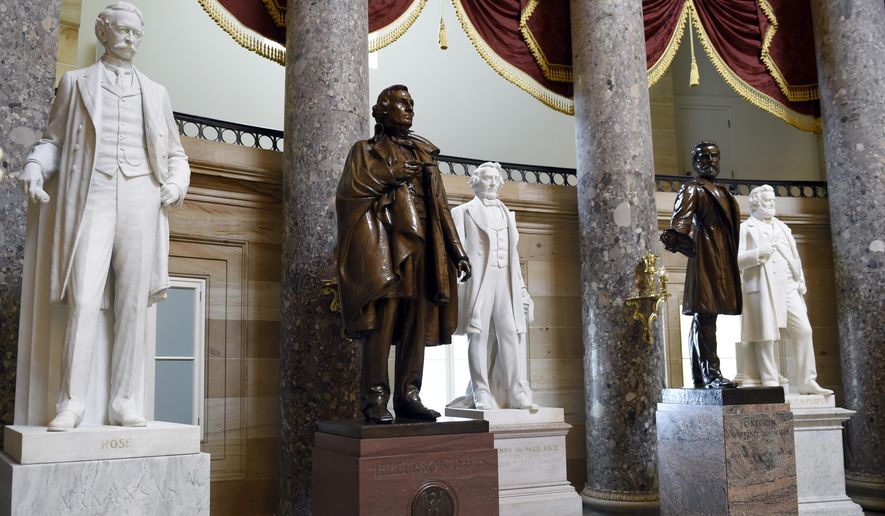WASHINGTON (AP) - At least 12 figures in the U.S. Capitol’s National Statuary Hall Collection honor men who gave their allegiance to the Confederate States of America during the Civil War. In the eyes of their states, service to the Confederacy was not their only accomplishment.
House Speaker Nancy Pelosi, D-Calif., is calling to have the statues of Confederates removed from the Capitol, though she cannot do so unilaterally. Each of the 50 states is allowed by law to place two statues in the collection.
Nearly all of the 12 took up arms against the U.S. while serving with Confederate forces or were Confederate officials. Many had been state or U.S. officials before the war began in 1861. After the war ended, in 1865, several became members of the U.S. House or Senate or both. One was appointed chief justice of the United States.
All but one of these statues were given to the Capitol in the first three decades of the 20th century, a period when segregation laws were taking hold in the South and the Confederate cause was widely rationalized and romanticized despite its core goal of retaining slavery.
States with statues honoring those with a Confederate background, the men they represent, and the year each statue was presented to the Capitol:
ALABAMA
Joseph Wheeler (1925) — A lieutenant general in the Confederate army, he later represented his state in the House for eight terms and fought with the U.S. Army in the Spanish-American War. Wheeler is buried in Arlington National Cemetery.
ARKANSAS
Uriah Milton Rose (1917) — The top official for his state’s largest county when the war began, he opposed leaving the Union but was loyal to Arkansas and the Confederacy. A lawyer and scholar, he later became president of the American Bar Association and a U.S. ambassador. Last year Arkansas officials approved replacing the statues of Rose and white supremacist governor and senator James P. Clarke with statues of singer Johnny Cash and civil rights leader Daisy Bates.
FLORIDA
Edmund Kirby Smith (1922) — A graduate of West Point, he resigned from the U.S. Army to join the Confederacy. Smith died in 1893, the war’s last surviving full general of either the Confederacy or the U.S.
GEORGIA
Alexander Hamilton Stephens (1927) — The vice president of the Confederacy. Before the war he was elected to eight terms in the House, then returned to the House for five terms after the war, resigning to become Georgia’s governor.
Crawford Long (1926) — He was a doctor who, in the 1840s, discovered the value of ether during surgery. Long’s connection with Confederate forces is unclear; some sources say he enlisted at the age of 49 but was not called to active duty.
LOUISIANA
Edward Douglass White (1955) — He was a teenager when he enlisted in the Confederate army, only to be captured a short time later. He joined the Senate in 1891, was appointed to the U.S. Supreme Court in 1894 and was appointed chief justice in 1910.
MISSISSIPPI
Jefferson Davis (1931) — The president of the Confederacy. Before the Civil War, the West Point graduate fought in the Mexican War, served as secretary of war under President Franklin Pierce, and served in the House and Senate.
James Zachariah George (1931) — He served as a Confederate army colonel and after the war was the chief justice of the Mississippi Supreme Court and later a senator.
NORTH CAROLINA
Zebulon Vance (1916) — He left the House to join a military unit in North Carolina and later became a colonel, then spent most of the war as governor. Years later he was elected governor again and then served in the Senate.
SOUTH CAROLINA
Wade Hampton (1929) — A state lawmaker before the war, he rose to the rank of lieutenant general in the Confederate army. Later a governor, he too found a career in Washington politics as a senator and federal railroad commissioner.
VIRGINIA
Robert E. Lee (1909) — The commander of the Army of Northern Virginia, the Confederacy’s most prominent force, and the South’s most venerated war hero. A West Point graduate and career officer who had served as superintendent of the military academy before the war, Lee turned down the command of the U.S. Army and chose the Confederacy instead.
WEST VIRGINIA
John Kenna (1901) — He was wounded at 16 while serving in the Confederate army and would later become a congressman and senator. Kenna was born in 1848 in Virginia’s Kanawha County, which would become part of the new state of West Virginia in 1863.
___
Main sources: Architect of the Capitol;Biographical Dictionary of the U.S. Congress.




Please read our comment policy before commenting.